De nombreux propriétaires de sites Web ne réalisent pas qu'ils peuvent exécuter plusieurs installations WordPress sur leur domaine. Que vous souhaitiez tester de nouveaux designs, créer un site de staging ou démarrer un nouveau projet sans acheter un autre domaine, une installation dans un sous-répertoire peut être incroyablement utile.
Cette approche nous a fait gagner d'innombrables heures de dépannage et a évité de nombreux désastres potentiels pour les sites Web. Pour cette raison, nous avons trouvé que c'était l'une des astuces les plus utiles dans notre boîte à outils.
Le meilleur dans tout ça ? Installer WordPress dans un sous-répertoire n'est pas aussi complexe qu'il n'y paraît. Dans ce guide étape par étape, nous vous montrerons comment installer WordPress dans un sous-répertoire, tout comme nous l'avons fait d'innombrables fois pour nos propres projets.
À la fin de ce tutoriel, vous aurez une compréhension claire de la façon de créer une installation WordPress distincte sans interférer avec votre site principal.
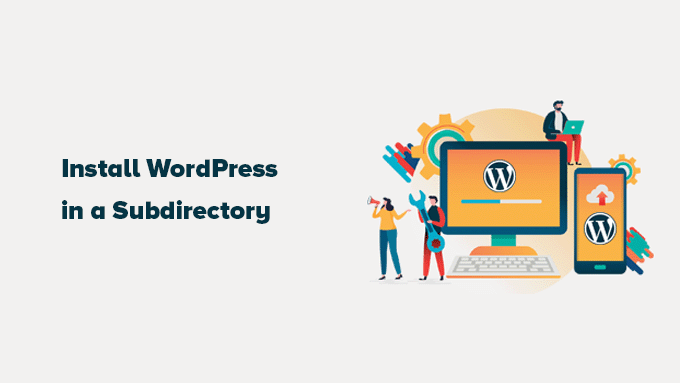
Voici un aperçu rapide de ce que nous allons aborder dans cet article :
- Sous-domaine vs. Sous-répertoire : Lequel est le meilleur pour le SEO ?
- Prérequis pour l'installation de WordPress dans un sous-répertoire
- Étape 1 : Créer un sous-répertoire sous le nom de domaine racine
- Étape 2 : Télécharger les fichiers WordPress
- Étape 3 : Créer une nouvelle base de données
- Étape 4 : Installer WordPress
- Étape 5 : Corriger les permaliens
Sous-domaine vs. Sous-répertoire : Lequel est le meilleur pour le SEO ?
Normalement, lorsque vous créez un site Web WordPress, vous le configurez sur son propre nom de domaine dédié (comme wpbeginner.com). Mais parfois, vous pourriez vouloir créer des sites Web supplémentaires en utilisant le même nom de domaine.
Heureusement, WordPress vous offre plusieurs façons de procéder. Vous pouvez soit installer WordPress dans un sous-domaine ((http://nouveausite.example.com) soit dans un sous-répertoire (http://example.com/nouveausite/).
Une question que l'on nous pose constamment est : lequel est le meilleur pour le SEO ? Analysons cela.
Les moteurs de recherche comme Google traitent les sous-domaines comme des sites web complètement distincts de votre domaine principal. Voyez cela ainsi : ils considèrent WPBeginner et notre site WPBeginner Vidéos comme deux entités distinctes. Cela signifie qu'un sous-domaine doit construire sa propre autorité et sa puissance de classement de manière indépendante.
D'un autre côté, les sous-répertoires bénéficient directement de l'autorité établie de votre domaine principal. Dans la plupart des cas, cela donne aux sous-répertoires une longueur d'avance pour se classer plus haut dans les résultats de recherche.
Si vous cherchez à créer des sites WordPress distincts en utilisant des sous-domaines ou des sous-répertoires, une méthode populaire consiste à installer un réseau WordPress multisite. Cela vous permet de gérer plusieurs sites à partir d'une seule installation WordPress.
Cependant, si vous avez besoin de maintenir ces sites web complètement séparés et gérés indépendamment, vous pouvez également installer différentes instances de WordPress. Pour faciliter la gestion de plusieurs installations WordPress distinctes, vous pouvez utiliser des outils de gestion de sites WordPress qui fournissent un tableau de bord unique pour tous vos sites.
Prérequis pour l'installation de WordPress dans un sous-répertoire
Bonne nouvelle ! L'installation de WordPress dans un sous-répertoire est généralement assez simple. Si vous avez déjà un site WordPress configuré sur votre domaine principal (comme votredomaine.com), vous êtes prêt. Vous n'avez rien de spécial à faire du côté de l'hébergement.
Cependant, si votre domaine principal héberge actuellement un site web statique (un site qui n'est pas construit avec WordPress), vous voudrez vérifier rapidement auprès de votre fournisseur d'hébergement web pour vous assurer qu'il prend en charge WordPress. La plupart des hébergeurs réputés le font, mais il est toujours bon de confirmer.
Si votre hébergeur actuel ne prend pas en charge WordPress, ne vous inquiétez pas. Il vous suffira de déplacer votre site web vers une autre société d'hébergement.
Nous recommandons vivement Bluehost. Ils offrent une réduction fantastique sur l'hébergement spécifiquement pour les utilisateurs de WPBeginner, et ils incluent même un nom de domaine gratuit.
Si vous utilisez un autre fournisseur d'hébergement, alors toutes les meilleures sociétés d'hébergement WordPress facilitent l'installation de plusieurs sites WordPress en utilisant le même compte d'hébergement.
Par exemple, si vous utilisez Bluehost, vous pouvez facilement ajouter une nouvelle installation WordPress directement depuis votre tableau de bord d'hébergement.
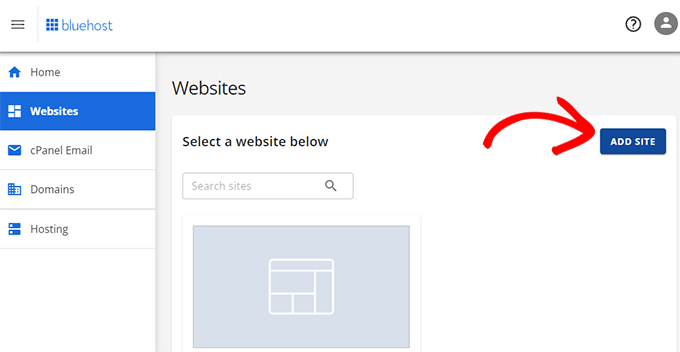
Cependant, n'oubliez pas que la plupart des comptes d'hébergement mutualisé ont des ressources serveur limitées. Si l'un de vos sites reçoit soudainement beaucoup de trafic, cela pourrait potentiellement ralentir ou affecter les performances de vos autres sites sur le même compte.
Si vous débutez, l'hébergement mutualisé est souvent tout à fait convenable. Cependant, à mesure que votre entreprise et le trafic de votre site augmentent, vous voudrez probablement envisager de passer à un hébergement WordPress géré pour de meilleures performances et une meilleure évolutivité.
Cela dit, examinons comment installer facilement WordPress dans un sous-répertoire.
Étape 1 : Créer un sous-répertoire sous le nom de domaine racine
Tout d'abord, vous devez créer un nouveau sous-répertoire (considérez-le comme un dossier) sous votre site web principal. C'est là que vous installerez tous les fichiers WordPress pour votre nouveau site.
Pour ce faire, vous devrez vous connecter à votre compte d'hébergement WordPress à l'aide d'un client FTP tel que FileZilla, ou de l'outil Gestionnaire de fichiers généralement disponible dans votre panneau de contrôle d'hébergement (comme cPanel).
Une fois connecté, accédez au dossier racine de votre site Web, qui est généralement le dossier /public_html/.
Si vous avez déjà un site Web WordPress installé sur votre domaine principal, vous verrez ici vos fichiers et dossiers WordPress existants.
Ensuite, vous devez créer le nouveau sous-répertoire. Faites un clic droit dans le dossier racine et recherchez des options telles que « Créer un nouveau répertoire » ou « Nouveau dossier ».
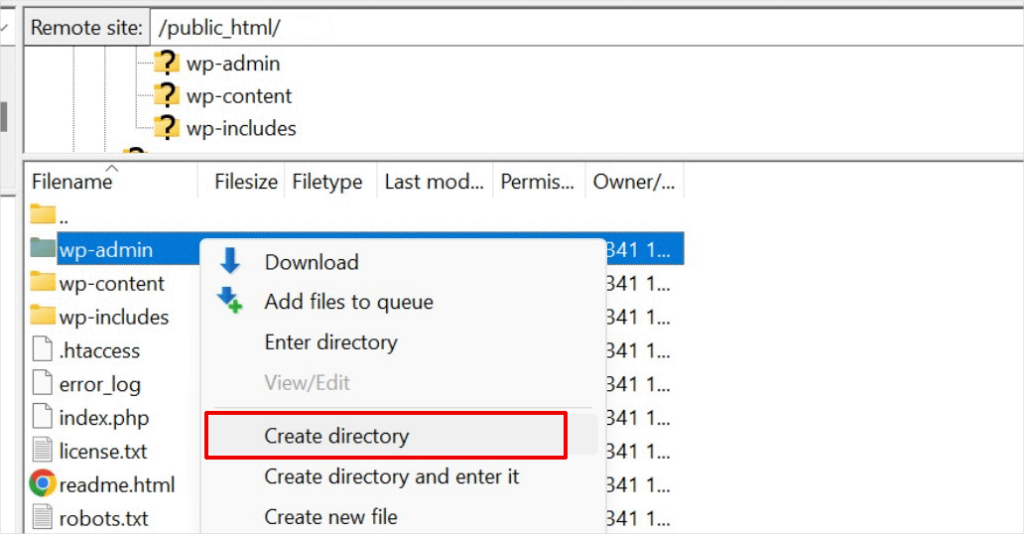
Maintenant, soyez prudent lorsque vous choisissez le nom de votre sous-répertoire. Ce nom fera partie de l'URL de votre nouveau site WordPress, et c'est ce que les gens taperont dans leur navigateur pour visiter ce site Web spécifique.
Par exemple, si vous nommez ce répertoire travel-guides, l'adresse de votre site Web WordPress sera : http://example.com/travel-guides/

Étape 2 : Télécharger les fichiers WordPress
Votre sous-répertoire nouvellement créé est vide pour le moment. Changeons cela en téléchargeant les fichiers WordPress.
Tout d'abord, vous devez visiter le site Web WordPress.org et cliquer sur le bouton « Télécharger ».
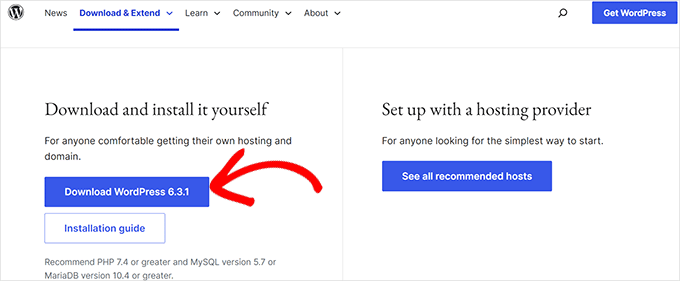
Votre navigateur téléchargera maintenant le fichier zip contenant le dernier logiciel WordPress sur votre ordinateur.
Après avoir téléchargé le fichier, vous devez le sélectionner et l'extraire :
- Utilisateurs Mac : Double-cliquez simplement sur le fichier zip téléchargé.
- Utilisateurs Windows : Faites un clic droit sur le fichier zip et choisissez l'option « Extraire tout ».
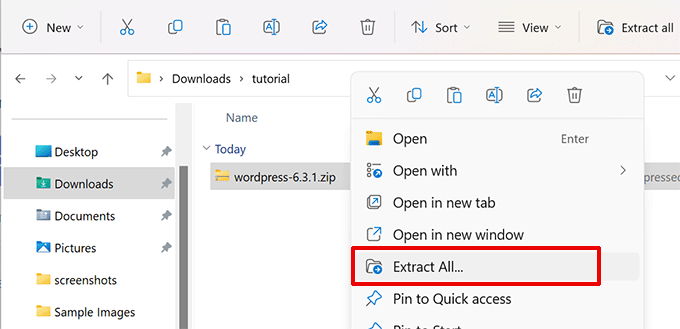
Après avoir extrait le fichier zip, vous verrez un dossier « wordpress ».
À l'intérieur du dossier wordpress, vous verrez tous les fichiers et dossiers principaux de WordPress.
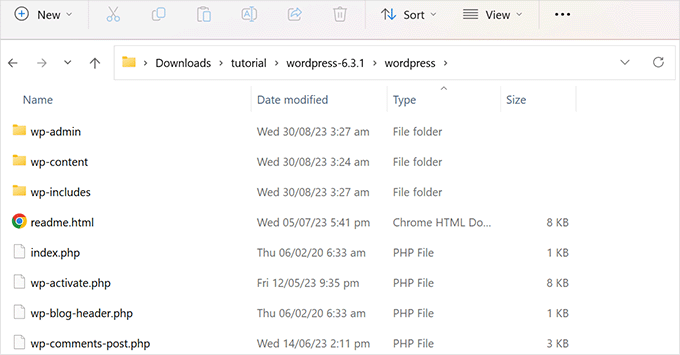
Maintenant, téléchargeons ces fichiers dans votre nouveau sous-répertoire.
Connectez-vous à votre site web à l'aide d'un client FTP et accédez au sous-répertoire que vous avez créé à la première étape. Dans le panneau des fichiers locaux de votre client FTP, accédez au dossier « wordpress » que vous venez d'extraire.
Sélectionnez maintenant tous les fichiers à l'intérieur du dossier et téléchargez-les dans votre nouveau sous-répertoire.
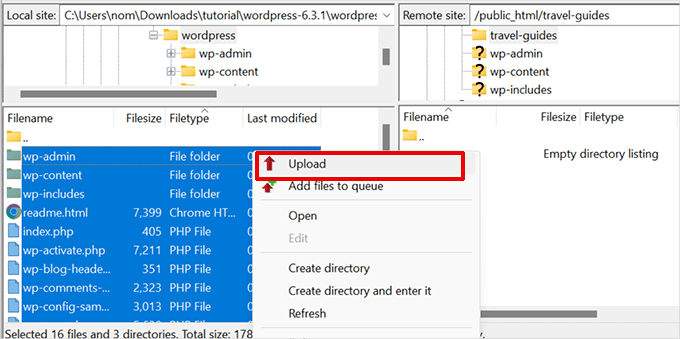
Étape 3 : Créer une nouvelle base de données
WordPress stocke tout votre contenu dans une base de données. Étant donné que vous installez un nouveau site WordPress dans un sous-répertoire, vous devrez créer une toute nouvelle base de données pour celui-ci.
Tout d'abord, connectez-vous au tableau de bord de votre compte d'hébergement WordPress et cliquez sur le bouton « Paramètres » sous votre site web.
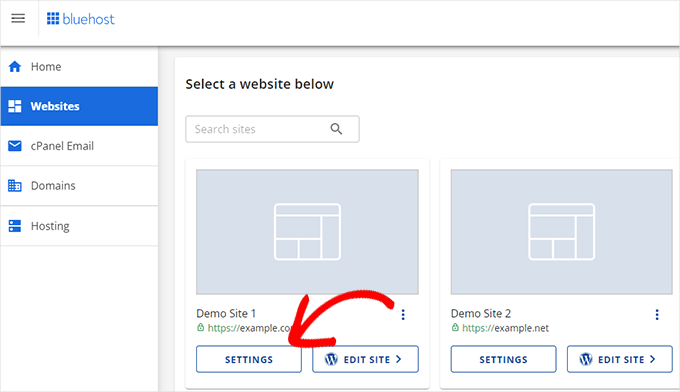
Après cela, passez à l'onglet « Avancé » dans le menu supérieur.
Faites défiler un peu vers le bas jusqu'à la section cPanel, puis cliquez sur « Gérer ».
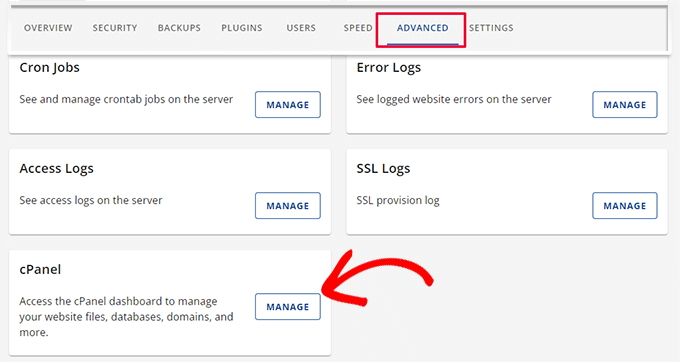
Cela lancera le cPanel ou le panneau de contrôle d'hébergement avancé.
À partir de là, vous devez cliquer sur « Bases de données MySQL » sous la section Bases de données.
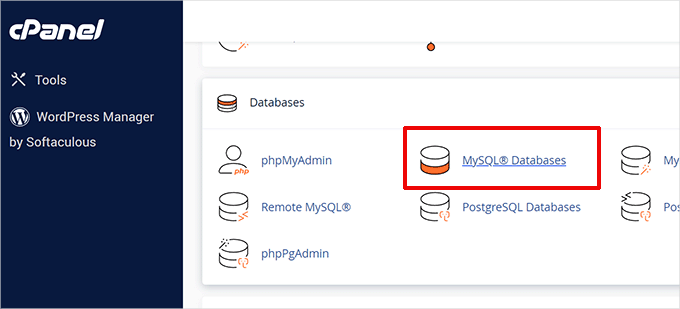
👆 Votre tableau de bord d'hébergement peut être légèrement différent des captures d'écran ci-dessus, mais les concepts de base sont les mêmes. Vous devez simplement trouver la zone où vous pouvez gérer les bases de données.
Sur l'écran suivant, entrez le nom que vous souhaitez donner à votre nouvelle base de données et cliquez sur le bouton « Créer la base de données ».
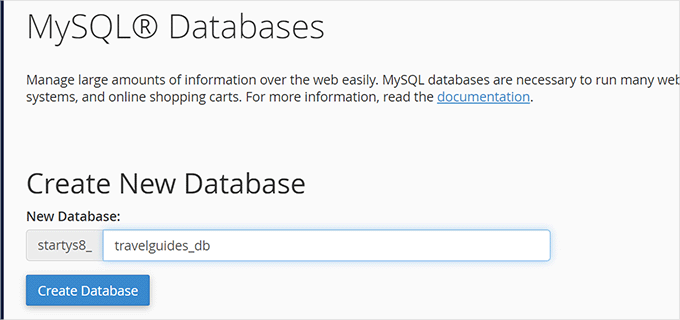
Votre tableau de bord cPanel va maintenant créer la nouvelle base de données MySQL. Une fois cela fait, cliquez sur le bouton « Retour » pour revenir à la page des bases de données.
Ensuite, vous devez créer un utilisateur MySQL qui aura la permission d'accéder et de gérer cette nouvelle base de données.
Faites simplement défiler vers le bas jusqu'à la section « Utilisateurs MySQL ». Ici, vous pourrez créer un nouveau nom d'utilisateur et un mot de passe fort pour cet utilisateur.
Une fois cela fait, cliquez sur le bouton « Créer l'utilisateur » pour continuer.
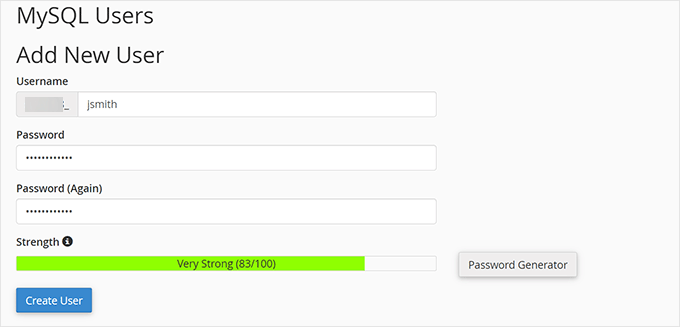
Enfin, vous devez connecter cet utilisateur à la base de données que vous avez créée précédemment et lui donner les autorisations nécessaires.
Faites défiler vers le bas jusqu'à la section « Ajouter un utilisateur à la base de données ». Sélectionnez le nom d'utilisateur MySQL que vous venez de créer dans le menu déroulant, puis sélectionnez le nom de la base de données que vous avez créée.
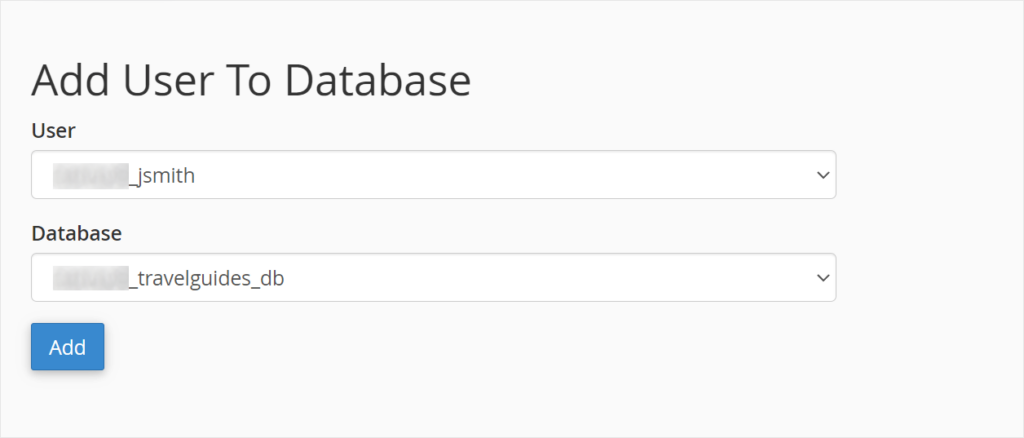
Cliquez sur le bouton « Ajouter » pour continuer.
cPanel accordera maintenant à l'utilisateur MySQL tous les privilèges sur votre base de données nouvellement créée.
Étape 4 : Installer WordPress
Maintenant que tout est en place, vous pouvez procéder à l'installation de WordPress.
Visitez le répertoire que vous avez créé précédemment dans un navigateur Web en tapant l'URL comme ceci :
http://example.com/votre-nom-de-sous-repertoire/
Cela ouvrira l'assistant d'installation de WordPress. Tout d'abord, sélectionnez la langue de votre site Web WordPress et cliquez sur le bouton « Continuer ».
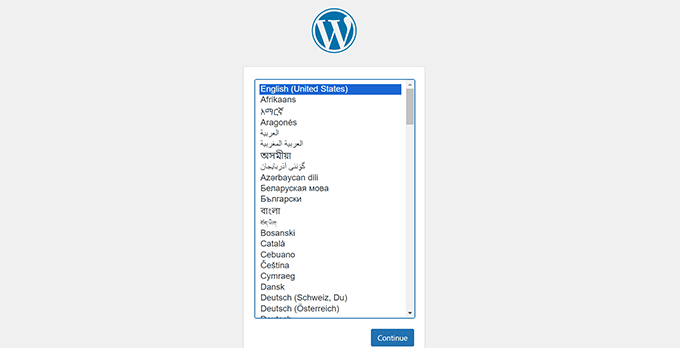
Ensuite, il vous sera demandé de fournir le nom de votre base de données WordPress, le nom d'utilisateur de la base de données, le mot de passe et l'hôte.
Entrez les détails de la base de données et cliquez sur le bouton « Soumettre ».
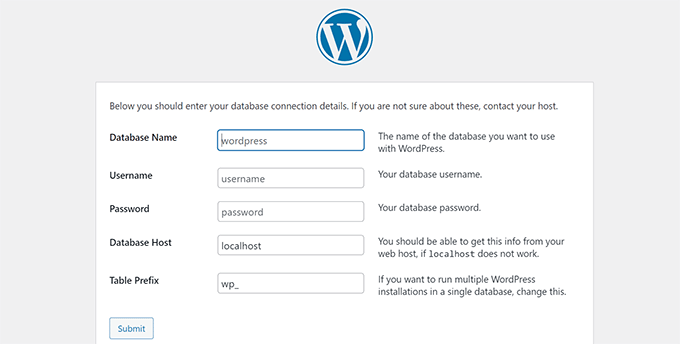
WordPress va maintenant se connecter à votre base de données.
Une fois la connexion établie, vous verrez un message de succès comme celui-ci :
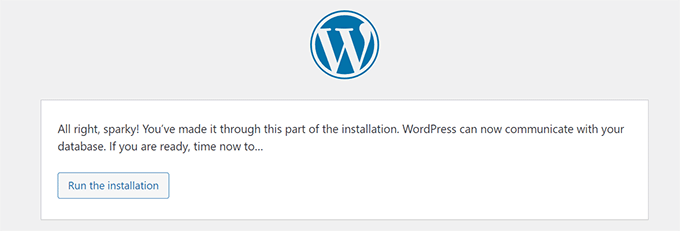
Cliquez sur le bouton « Exécuter l'installation » pour continuer.
Sur l'écran suivant, il vous sera demandé de fournir un titre pour votre site Web et de choisir un nom d'utilisateur administrateur, un mot de passe et une adresse e-mail.
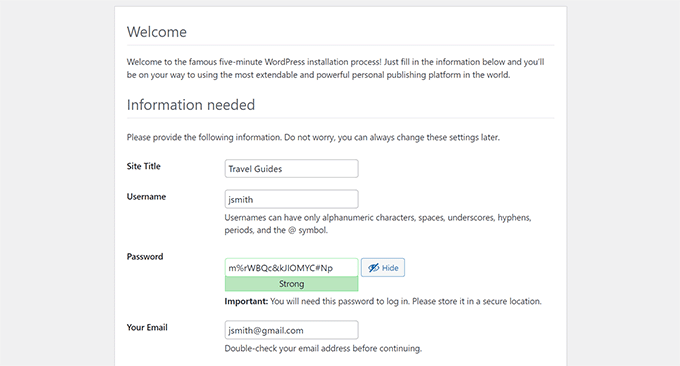
Après avoir saisi les détails de votre site Web, cliquez sur le bouton « Exécuter l'installation » pour continuer.
WordPress va maintenant configurer votre site Web et afficher un message de succès une fois que c'est terminé :
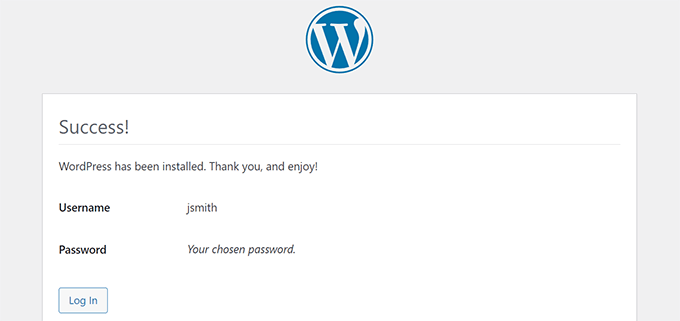
Vous pouvez maintenant vous connecter à votre nouveau site WordPress, qui est installé dans le sous-répertoire.
Étape 5 : Corriger les permaliens
Si vous avez déjà une installation WordPress distincte dans le répertoire racine, vous pourriez rencontrer un problème où le fichier .htaccess dans votre sous-répertoire provoque un conflit. Cela peut entraîner des erreurs 404 frustrantes sur votre nouveau site web dans le sous-répertoire.
Ne vous inquiétez pas, il existe une solution simple. Il vous suffit de modifier le fichier .htaccess dans votre installation WordPress du sous-répertoire. Remplacez le code à l'intérieur de votre fichier .htaccess par le code suivant :
# BEGIN WordPress
<IfModule mod_rewrite.c>
RewriteEngine On
RewriteBase /your-subdirectory/
RewriteRule ^index\.php$ - [L]
RewriteCond %{REQUEST_FILENAME} !-f
RewriteCond %{REQUEST_FILENAME} !-d
RewriteRule . /your-subdirectory/index.php [L]
</IfModule>
# END WordPress
Assurez-vous de remplacer /votre-sous-repertoire/ par le nom réel de votre sous-répertoire.
Nous espérons que cet article vous a aidé à installer WordPress dans un sous-répertoire. Ensuite, vous voudrez peut-être consulter notre guide sur comment créer un site web d'une seule page, ou consulter notre sélection d'experts des meilleurs constructeurs de pages glisser-déposer pour WordPress.
Si cet article vous a plu, abonnez-vous à notre chaîne YouTube pour des tutoriels vidéo WordPress. Vous pouvez également nous retrouver sur Twitter et Facebook.





Olaf
Un sous-domaine ou un sous-dossier peut être un excellent choix si vous avez besoin d'une nouvelle instance WordPress, par exemple, pour une boutique en ligne séparée ou un forum de discussion. Vous n'avez même pas besoin d'une nouvelle base de données. Tout peut être géré avec une seule base de données si vous choisissez un préfixe différent lors de l'installation. D'après ma propre expérience, cependant, .htaccess peut parfois causer des problèmes. Dans votre article, je vois pour la première fois que quelqu'un a pris le temps d'ajuster le code et a ajouté la ligne RewriteBase pour s'assurer que tout fonctionne comme il se doit. J'admire la minutie avec laquelle vous avez conçu vos tutoriels.
Dennis Muthomi
Excellent guide pour installer WordPress dans un sous-répertoire !
J'ai trouvé les instructions très claires, surtout la partie concernant la création d'une nouvelle base de données. Je viens de configurer plusieurs sites WordPress sous un même domaine et je peux garantir l'efficacité de cette méthode.
MERCI à toute l'équipe de WPBeginner !
John Pana
Puis-je intégrer un blog WordPress en tant que sous-répertoire (par exemple, abc.com/blog) à mon site Web Ruby on Rails existant ? Si oui, y a-t-il des étapes spécifiques que je dois suivre pour réaliser cette configuration ?
Support WPBeginner
Unless Ruby on Rails would override the file structure, you should be able to follow the steps in this article and have the site in a subdirectory with WordPress
Admin
Chanakya Sahu
Bonjour, j'ai créé un sous-répertoire à l'aide de la fonction d'installation automatique d'Hostinger pour mon blog d'actualités afin de créer un site complètement différent pour une langue différente. Par exemple : example.com/langue. Je vais y publier des articles uniques.
Je pourrais également y publier la version traduite (pas traduite par IA, je vais la traduire moi-même). Est-ce que cela affecte le SEO ? Dois-je traduire certains articles ou laisser faire Google ?
Support WPBeginner
Vous devriez vérifier auprès de votre plugin SEO pour vous assurer que le balisage correct est ajouté et cela ne devrait pas affecter votre SEO.
Admin
Prem Krishnan P
J'ai installé WordPress dans le sous-répertoire. (c'est-à-dire www.example.com/blog) et maintenant j'ai créé un article de test (c'est-à-dire www.example.com/blog/test. Est-il possible de supprimer le sous-répertoire de l'URL ? Je cherche quelque chose comme example.com/test (c'est-à-dire www. Nomdusite.com/Nomdelarticle)
Support WPBeginner
Si vous souhaitez faire cela, nous n'avons pas de recommandation spécifique pour y parvenir et il serait probablement préférable de placer l'article sur votre domaine principal pour y parvenir.
Admin
Jiří Vaněk
Cela peut être fait en utilisant le fichier .htaccess, qui est le fichier de configuration Apache sous Linux. Il est possible d'uploader des règles dans ce fichier, qui peuvent être utilisées pour réécrire les adresses URL dans le navigateur. Cependant, c'est un sujet relativement complexe et il faut aborder une telle intervention avec sensibilité.
Yevhenii Korchak
Thanks for the tutorial! Very helpful. You’re the best
Support WPBeginner
Merci et nous sommes heureux d'apprendre que notre tutoriel a été utile !
Admin
Mangkutak
ce type d'installation WordPress peut-il toujours activer la fonctionnalité multisite si je veux l'activer pour mon site WordPress. J'ai entendu dire il y a longtemps que ce n'était pas possible, est-ce toujours le cas aujourd'hui ?
Support WPBeginner
Vous pouvez convertir un site en une installation multisite.
Admin
Mohammed
bonjour,
J'ai fait les mêmes étapes, une fois que j'ai installé WordPress et fait quelques tests, j'ai constaté que je ne pouvais pas enregistrer les articles ou les publier. un message d'erreur apparaît
La mise à jour a échoué. La réponse n'est pas une réponse JSON valide.
s'il vous plaît aidez-moi.
Support WPBeginner
Pour l'erreur JSON invalide, nous vous recommandons de consulter notre article ci-dessous !
https://www.wpbeginner.com/wp-tutorials/how-to-fix-the-invalid-json-error-in-wordpress-beginners-guide/
Admin
alan
Merci pour ce tutoriel. Je n'étais pas sûr si je devais créer la base de données au préalable ou la créer pendant le processus d'installation.
Support WPBeginner
Heureux que notre guide vous ait été utile !
Admin
Giwa
Bonjour, ces étapes sont explicites mais dans mon cas, notre site web principal ne fonctionne pas sur WordPress cependant nous voulons faire fonctionner WordPress sur un sous-répertoire /blog.
Comment procéder
le site web principal fonctionne sur NodeJs
Support WPBeginner
Vous devriez toujours pouvoir suivre les étapes de ce guide pour ce que vous voulez faire.
Admin
Abid Hasan
Aujourd'hui, j'ai configuré mon nouveau WordPress dans un sous-répertoire. Je n'ai pas eu besoin de modifier le fichier .htaccess. Je pense que WP est tellement intelligent maintenant qu'il peut gérer cela automatiquement.
Support WPBeginner
Thanks for sharing, your hosting provider may have also set it up for you when installing as certain hosts set that up for you now.
Admin
Goran
Merci beaucoup pour ce super tutoriel sans aucun problème.
Support WPBeginner
Glad our guide was helpful
Admin
Sam
Merci pour ce guide.
Nous prévoyons d'avoir des sous-répertoires sur notre prochain site web. Ce guide a vraiment clarifié les choses.
Une question cependant,
Y a-t-il une limite au nombre de sous-répertoires qu'un site web WordPress peut avoir ?
Support WPBeginner
Il n'y a pas de limite stricte au nombre de répertoires pour le moment.
Admin
Swetha
Salut.. merci pour cet article… je n'arrive pas à télécharger les dossiers wp-admin, wp-content et wp-includes dans le sous-répertoire… les autres fichiers sont téléchargés… comment puis-je télécharger tout cela ???
Support WPBeginner
Cela dépendrait de la raison pour laquelle vous n'y arrivez pas. Si vous contactez votre fournisseur d'hébergement, il devrait pouvoir vous aider, mais il pourrait s'agir d'un problème de permissions avec votre utilisateur.
Admin
Arinze
Merci, ça a fonctionné.
Est-il possible de changer le nom du sous-répertoire dans l'URL, par exemple example.com/seo/how-to-rank en example.com/how-to-rank
Support WPBeginner
Si vous ne souhaitez pas que vos URL contiennent le sous-répertoire, nous vous recommandons d'installer le site sur votre domaine principal plutôt que de créer des redirections pour le supprimer de l'URL.
Admin
Arinze
Merci pour cet article. Il est très instructif.
L'installation de WordPress dans le sous-dossier affectera-t-elle la vitesse globale du site.
Support WPBeginner
It should not
Admin
dennis wille
il y a une erreur apparente dans votre exemple de code htaccess
devrait être
# BEGIN WordPress
RewriteEngine On
RewriteBase /votre-sous-repertoire/
RewriteRule ^index\.php$ – [L]
RewriteCond %{REQUEST_FILENAME} !-f
RewriteCond %{REQUEST_FILENAME} !-d
RewriteRule . /votre-sous-repertoire/index.php [L]
# END WordPress
notez le changement de la ligne 5 de rewriterule
Support WPBeginner
Thank you for catching that, while not specifically required, we’ll look to update the article
Admin
Deddy Hidayat
Je veux construire un site web avec un sous-répertoire WordPress, le premier site est domain.com, et le second site est domain.com/blog… d'après ce que je sais, WordPress utilise domain.com/blog comme article par défaut… cela nuira-t-il au SEO ?
Support WPBeginner
WordPress n'utilise pas /blog par défaut, c'est seulement l'URL la plus courante à utiliser. Utiliser blog pour un sous-répertoire ne devrait pas avoir d'effet majeur sur le SEO.
Admin
Shashank Dubbewar
est-il nécessaire d'installer et de gérer les mêmes plugins séparément si j'ai installé WordPress sur le domaine principal et sur un sous-répertoire chacun et que je gère les sites WordPress séparément ?
Support WPBeginner
S'il s'agit d'un site différent, même dans un sous-répertoire, les plugins sont gérés pour chaque site individuel. Vous pouvez également consulter certains outils recommandés pour gérer plusieurs sites dans notre article ci-dessous :
https://www.wpbeginner.com/showcase/how-to-easily-manage-multiple-wordpress-sites/
Admin
Mohd Kaleem
Bonjour Monsieur, puis-je créer un sous-répertoire sans me connecter à Cpanel. J'ai oublié mes détails d'hébergement. Mais j'ai les détails de WP, est-il possible de créer un sous-répertoire en utilisant WordPress avec un plugin ou par un autre moyen ?
Support WPBeginner
Vous auriez besoin d'accéder à votre hébergement, vous devriez pouvoir contacter votre fournisseur d'hébergement pour obtenir de l'aide afin de vous reconnecter à votre compte.
Admin
Kosi
Merci. Ça a marché ! Vraiment reconnaissant….
Support WPBeginner
You’re welcome, glad our guide was helpful
Admin
Nicoleiver
Bonjour, je voudrais demander s'il est possible de copier tous les fichiers de mon dossier actuel vers le sous-répertoire ? Parce que je veux avoir le même modèle et le même plugin pour mon site de sous-répertoire.
Support WPBeginner
Pour commencer, vous pourriez consulter notre guide sur la création d'un site de staging ci-dessous et, au lieu d'installer le site sur staging, vous pourriez avoir tout votre contenu sur le sous-domaine de votre choix et modifier le contenu pour qu'il corresponde à celui de votre nouveau site. Vous pouvez trouver notre guide sur la configuration d'un site de staging ci-dessous :
https://www.wpbeginner.com/wp-tutorials/how-to-create-staging-environment-for-a-wordpress-site
Admin
John Doe
Et si je créais un nouveau sous-répertoire à partir d'un autre sous-répertoire, la correction des permaliens serait-elle toujours pertinente et fonctionnerait-elle sans problème ?
Par exemple, j'ai firstwebsite.com/firstsubdir/ le deuxième sous-répertoire sera firstwebsite.com/firstsubdir/secsubdir/ dois-je toujours utiliser la même correction pour le permalien ?
Désolé, l'anglais n'est pas ma première langue.
Support WPBeginner
Vous devrez inclure le deuxième sous-répertoire dans la modification du permalien et cela devrait toujours fonctionner.
Admin
keram
Merci pour ce tutoriel clair.
Est-il possible d'installer WP dans un sous-répertoire mais d'utiliser l'URL du domaine principal pour y accéder et d'avoir toujours l'URL principale affichée dans la barre d'adresse du navigateur ?
Pour clarifier :
J'installerais WP dans mydomain.com/sub/ mais j'aimerais y accéder en ouvrant mydomain.com et avoir mydomain.com affiché dans le navigateur afin que les visiteurs puissent mettre mon URL en favori.
Est-il possible de le configurer ?
Support WPBeginner
C'est possible mais cela dépendrait de votre fournisseur d'hébergement pour voir si c'est autorisé. Si vous contactez votre fournisseur d'hébergement, il devrait être en mesure de vous aider.
Admin
keram
Les pages se chargeront-elles plus rapidement si WP est installé dans le sous-répertoire ?
Support WPBeginner
L'emplacement de votre site sur votre hébergeur ne devrait pas affecter de manière notable le temps de chargement de votre site.
Ghulam Mujtaba
Salam, je viens de finir de lire l'article et j'ai une question, comment puis-je avoir le même en-tête et pied de page que l'installation WordPress dans le répertoire parent ? Je serais ravi et reconnaissant si vous me donniez un indice, Merci...
Support WPBeginner
Pour cela, la méthode la plus simple serait d'installer le même thème sur les deux sites.
Admin
Priscilla
Bonjour,
Merci pour ce super tuto, ça marche !
Support WPBeginner
Glad our guide was helpful
Admin
Sohail
Très utile ! Une question s'il vous plaît.
Dois-je ajouter cette ligne :
RewriteBase /votre-sous-repertoire/
pour chaque installation dans un sous-répertoire d'une installation WordPress principale ?
Merci
Support WPBeginner
Oui, nous recommandons cela pour éviter tout problème dans le sous-répertoire.
Admin
Samantha
Merci pour cette information ! Cela m'a beaucoup aidé !
Support WPBeginner
You’re welcome, glad our guide could help
Admin
Alex
Bonjour. J'ai copié manuellement mes fichiers WordPress dans le dossier racine, sans le plugin. J'ai ensuite copié la base de données d'origine dans une nouvelle, où j'ai remplacé le siteurl pour refléter le nouvel emplacement, le dossier racine. Dans le fichier wp-config à la racine, j'ai modifié WP_HOME et WP_SITEURL pour supprimer le /wordpress.
En conséquence, j'ai pu accéder à wp-login pour mon nouvel emplacement, mais pas plus loin.
Et lorsque j'ai visité mon site, j'ai reçu un avertissement « trop de redirections ».
Des conseils ?
Support WPBeginner
Il y a plusieurs raisons possibles. Pour commencer, vous voudrez peut-être suivre les étapes de notre article ici : https://www.wpbeginner.com/wp-tutorials/how-to-fix-error-too-many-redirects-issue-in-wordpress/
Admin
Abhishek mahajan
Merci beaucoup pour le guide étape par étape sur les sous-dossiers WP. Une chose que je ne comprends jamais, c'est comment créer un sitemap XML exact pour Google Actualités dans WordPress ?
Support WPBeginner
La plupart des plugins SEO devraient ajouter le balisage requis pour que vous puissiez être ajouté à Google Actualités. Si vous utilisez un plugin SEO, vous devriez contacter le support du plugin pour connaître leurs recommandations de configuration.
Admin
Hesam
Merci pour votre article. J'ai une question concernant la transformation de ce sous-domaine ou sous-répertoire WordPress installé en racine principale du site web et son remplacement par le site principal. Que dois-je faire ?
Support WPBeginner
Cela dépendrait de ce que vous entendez par là, vous pouvez consulter notre guide ici : https://www.wpbeginner.com/wp-tutorials/how-to-get-rid-of-wordpress-from-your-wordpress-site-url/
Admin
Umesh Yellaboina
Salut l'équipe, Merci pour cette publication, non seulement celles-ci… toutes les autres publications de votre blog nous sont très utiles, j'apprécie vraiment votre travail. Merci beaucoup pour celles-ci.
Et j'ai besoin d'un peu d'aide, j'ai en fait fait la même chose que dans cette publication, j'ai installé WordPress dans un sous-répertoire, mais je rencontre un petit problème, c'est-à-dire que je ne reçois pas les e-mails du formulaire de contact, quand il était sur un sous-domaine, cela fonctionnait bien, mais quand il est installé dans un sous-répertoire, je ne reçois pas les soumissions du formulaire, il continue de charger mais ne se soumet pas. S'il vous plaît, aidez-moi avec ça. Merci.
Support WPBeginner
S'ils ne sont pas stockés sur votre site alors qu'ils devraient l'être lorsqu'ils sont soumis, vous devriez contacter le support de votre plugin de formulaire. Si vous ne recevez pas d'e-mail, vous voudrez probablement utiliser SMTP : https://www.wpbeginner.com/plugins/how-to-send-email-in-wordpress-using-the-gmail-smtp-server/
Admin
David
Merci pour l'information. Je lis tous les articles que vous écrivez.
J'ai juste un doute. J'ai créé une nouvelle installation WP via mon fournisseur d'hébergement, mais en cherchant, il n'y a pas de fichier .htaccess dans le sous-répertoire. Est-il obligatoire d'avoir un nouveau fichier .htaccess ? Cela va-t-il créer des erreurs à l'avenir ?
Support WPBeginner
WordPress should generate the htaccess file if you resave your permalinks. If you still don’t see it you may not have the option to show hidden files enabled
Admin
Rubens
merciiiiiiiiiiiiiiiiiiiiiiiiiiiiiiiiiiiiiiiiiiiiiiiiiiiiiiiiiiiiiiiiiiiiiiiiiiiiiiiiiiiiiiiiiiiiiiiiiiiiiiiiiiiiiiiiiiiiiiiiiiiiiiiiiiiiiiiiiiiiiiiiiiiiiiiiiiiiiiiiiiiiiiiiiiiiiiiiiiiiiiiiiiiiiiiiiiiiiiiiiiiiiiiiiiiiiiiiiiiiiiiiiiiiiiiiiiiiiiiiiiiiiiiiiiiiiiiiiiiiiiiiiiiiiiiiiiiiiiiiiiiiiiiiiiiiiiiiiiiiiiiiiiiiiiiiiiiiiiiiiiiiiiiiiiiiiiiiiiiiiiiiiiiiiiiiiiiiiiiiiiiiiiiiiiiiiiiiiiiiiiiiiiiiiiiiiiiiiiiiiiiiiiiiiiiiiiiiiiiiiiiiiiiiiiiiiiiiiiiiiiiiiiiiiiiiiiiiiiiiiiiiiiiiiiiiiiiiiiiiiiiiiiiiiiiiiiiiiiiiiiiiiiiiiiiiiiiiiiiiiiiiiiiiiiiiiiiiiiiiiiiiiiiiiiiiiiiiiiiiiiiiiiiiiiiiiiiiiiiiiiiiiiiiiiiiiiiiiiiiiiiiiiiiiiiiiiiiiiiiiiiiiiiiiiiiiiiiiiiiiiiiiiiiiiiiiiiiiiiiiiiiiiiiiiiiiiiiiiiiiiiiiiiiiiiiiiiiiiiiiiiiiiiiiiiiiiiiiiiiiiiiiiiiiiiiiiiiiiiiiiiiiiiiiiiiiiiiiiiiiiiiiiiiiiiiiiiiiiiiiiiiiiiiiiiiiiiiiiiiiiiiiiiiiiiiiiiiiiiiiiiiiiiiiiiiiiiiiiiiiiiiiiiiiiiiiiiiiiiiiiiiiiiiiiiiiiiiiiiiiiiiiiiiiiiiiiiiiiiiiiiiiiiiiiiiiiiiiiiiiiiiiiiiiiiiiiiiiiiiiiiiiiiiiiiiiiiiiiiiiiiiiiiiiiiiiiiiiiiiiiiiiiiiiiiiiiiiiiiiiiiiiiiiiiiiiiiiiiiiiiiiiiiiiiiiiiiiiiiiiiiiiiiiiiiiiiiiiiiiiiiiiiiiiiiiiiiiiiiiiiiiiiiiiiiiiiiiiiiiiiiiiiiiiiiiiiiiiiiiiiiiiiiiiiiiiiiiiiiiiiiiiiiiiiiiiiiiiiiiiiiiiiiiiiiiiiiiiiiiiiiiiiiiiiiiiiiiiiiiiiiiiiiiiiiiiiiiiiiiiiiiiiiiiiiiiiiiiiiiiiiiiiiiiiiiiiiiiiiiiiiiiiiiiiiiiiiiiiiiiiiiiiiiiiiiiiiiiiiiiiiiiiiiiiiiiiiiiiiiiiiiiiiiiiiiiiiiiiiiiiiiiiiiiiiiiiiiiiiiiiiiiiiiiiiiiiiiiiiiiiiiiiiiiiiiiiiiiiiiiiiiiiiiiiiiiiiiiiiiiiiiiiiiiiiiiiiiiiiiiiiiiiiiiiiiiiiiiiiiiiiiiiiiiiiiiiiiiiiiiiiiiiiiiiiiiiiiiiiiiiiiiiiiiiiiiiiiiiiiiiiiiiiiiiiiiiiiiiiiiiiiiiiiiiiiiiiiiiiiiiiiiiiiiiiiiiiiiiiiiiiiiiiiiiiiiiiiiiiiiiiiiiiiiiiiiiiiiiiiiiiiiiiiiiiiiiiiiiiiiiiiiiiiiiiiiiiiiiiiiiiiiiiiiiiiiiiiiiiiiiiiiiiiiiiiiiiiiiiiiiiiiiiiiiiiiiiiiiiiiiiiiiiiiiiiiiiiiiiiiiiiiiiiiiiiiiiiiiiiiiiiiiiiiiiiiiiiiiiiiiiiiiiiiiiiiiiiiiiiiiiiiiiiiiiiiiiiiiiiiiiiiiiiiiiiiiiiiiiiiiiiiiiiiiiiiiiiiiiiiiiiiiiiiiiiiiiiiiiiiiiiiiiiiiiiiiiiiiiiiiiiiiiiiiiiiiiiiiiiiiiiiiiiiiiiiiiiiiiiiiiiiiiiiiiiiiiiiiiiiiiiiiiiiiiiiiiiiiiiiiiiiiiiiiiiiiiiiiiiiiiiiiiiiiiiiiiiiiiiiiiiiiiiiiiiiiiiiiiiiiiiiiiiiiiiiiiiiiiiiiiiiiiiiiiiiiiiiiiiiiiiiiiiiiiiiiiiiiiiiiiiiiiiiiiiiiiiiiiiiiiiiiiiiiiiiiiiiiiiiiiiiiiiiiiiiiiiiiiiiiiiiiiiiiiiiiiiiiiiiiiiiiiiiiiiiiiiiiiiiiiiiiiiiiiiiiiiiiiiiiiiiiiiiiiiiiiiiiiiiiiiiiiiiiiiiiiiiiiiiiiiiiiiiiiiiiiiiiiiiiiiiiiiiiiiiiiiiiiiiiiiiiiiiiiiiiiiiiiiiiiiiiiiiiiiiiiiiiiiiiiiiiiiiiiiiiiiiiiiiiiiiiiiiiiiiiiiiiiiiiiiiiiiiiiiiiiiiiiiiiiiiiiiiiiiiiiiiiiiiiiiiiiiiiiiiiiiiiiiiiiiiiiiiiiiiiiiiiiiiiiiiiiiiiiiiiiiiiiiiiiiiiiiiiiiiiiiiiiiiiiiiiiiiiiiiiiiiiiiiiiiiiiiiiiiiiiiiiiiiiiiiiiiiiiiiiiiiiiiiiiiiiiiiiiiiiiiiiiiiiiiiiiiiiiiiiiiiiiiiiiiiiiiiiiiiiiiiiiiiiiiiiiiiiiiiiiiiiiiiiiiiiiiiiiiiiiiiiiiiiiiiiiiiiiiiiiiiiiiiiiiiiiiiiiiiiiiiiiiiiiiiiiiiiiiiiiiiiiiiiiiiiiiiiiiiiiiiiiiiiiiiiiiiiiiiiiiiiiiiiiiiiiiiiiiiiiiiiiiiiiiiiiiiiiiiiiiiiiiiiiiiiiiiiiiiiiiiiiiiiiiiiiiiiiiiiiiiiiiiiiiiiiiiiiiiiiiiiiiiiiiiiiiiiiiiiiiiiiiiiiiiiiiiiiiiiiiiiiiiiiiiiiiiiiiiiiiiiiiiiiiiiiiiiiiiiiiiiiiiiiiiiiiiiiiiiiiiiiiiiiiiiiiiiiiiiiiiiiiiiiiiiiiiiiiiiiiiiiiiiiiiiiiiiiiiiiiiiiiiiiiiiiiiiiiiiiiiiiiiiiiiiiiiiiiiiiiiiiiiiiiiiiiiiiiiiiiiiiiiiiiiiiiiiiiiiiiiiiiiiiiiiiiiiiiiiiiiiiiiiiiiiiiiiiiiiiiiiiiiiiiiiiiiiiiiiiiiiiiiiiiiiiiiiiiiiiiiiiiiiiiiiiiiiiiiiiiiiiiiiiiiiiiiiiiiiiiiiiiiiiiiiiiiiiiiiiiiiiiiiiiiiiiiiiiiiiiiiiiiiiiiiiiiiiiiiiiiiiiiiiiiiiiiiiiiiiiiiiiiiiiiiiiiiiiiiiiiiiiiiiiiiiiiiiiiiiiiiiiiiiiiiiiiiiiiiiiiiiiiiiiiiiiiiiiiiiiiiiiiiiiiiiiiiiiiiiiiiiiiiiiiiiiiiiiiiiiiiiiiiiiiiiiiiiiiiiiiiiiiiiiiiiiiiiiiiiiiiiiiiiiiiiiiiiiiiiiiiiiiiiiiiiiiiiiiiiiiiiiiiiiiiiiiiiiiiiiiiiiiiiiiiiiiiiiiiiiiiiiiiiiiiiiiiiiiiiiiiiiiiiiiiiiiiiiiiiiiiiiiiiiiiiiiiiiiiiiiiiiiiiiiiiiiiiiiiiiiiiiiiiiiiiiiiiiiiiiiiiiiiiiiiiiiiiiiiiiiiiiiiiiiiiiiiiiiiiiiiiiiiiiiiiiiiiiiiiiiiiiiiiiiiiiiiiiiiiiiiiiiiiiiiiiiiiiiiiiiiiiiiiiiiiiiiiiiiiiiiiiiiiiiiiiiiiiiiiiiiiiiiiiiiiiiiiiiiiiiiiiiiiiiiiiiiiiiiiiiiiiiiiiiiiiiiiiiiiiiiiiiiiiiiiiiiiiiiiiiiiiiiiiiiiiiiiiiiiiiiiiiiiiiiiiiiiiiiiiiiiiiiiiiiiiiiiiiiiiiiiiiiiiiiiiiiiiiiiiiiiiiiiiiiiiiiiiiiiiiiiiiiiiiiiiiiiiiiiiiiiiiiiiiiiiiiiiiiiiiiiiiiiiiiiiiiiiiiiiiiiiiiiiiiiiiiiiiiiiiiiiiiiiiiiiiiiiiiiiiiiiiiiiiiiiiiiiiiiiiiiiiiiiiiiiiiiiiiiiiiiiiiiiiiiiiiiiiiiiiiiiiiiiiiiiiiiiiiiiiiiiiiiiiiiiiiiiiiiiiiiiiiiiiiiiiiiiiiiiiiiiiiiiiiiiiiiiiiiiiiiiiiiiiiiiiiiiiiiiiiiiiiiiiiiiiiiiiiiiiiiiiiiiiiiiiiiiiiiiiiiiiiiiiiiiiiiiiiiiiiiiiiiiiiiiiiiiiiiiiiiiiiiiiiiiiiiiiiiiiiiiiiiiiiiiiiiiiiiiiiiiiiiiiiiiiiiiiiiiiiiiiiiiiiiiiiiiiiiiiiiiiiiiiiiiiiiiiiiiiiiiiiiiiiiiiiiiiiiiiiiiiiiiiiiiiiiiiiiiiiiiiiiiiiiiiiiiiiiiiiiiiiiiiiiiiiiiiiiiiiiiiiiiiiiiiiiiiiiiiiiiiiiiiiiiiiiiiiiiiiiiiiiiiiiiiiiiiiiiiiiiiiiiiiiiiiiiiiiiiiiiiiiiiiiiiiiiiiiiiiiiiiiiiiiiiiiiiiiiiiiiiiiiiiiiiiiiiiiiiiiiiiiiiiiiiiiiiiiiiiiiiiiiiiiiiiiiiiiiiiiiiiiiiiiiiiiiiiiiiiiiiiiiiiiiiiiiiiiiiiiiiiiiiiiiiiiiiiiiiiiiiiiiiiiiiiiiiiiiiiiiiiiiiiiiiiiiiiiiiiiiiiiiiiiiiiiiiiiiiiiiiiiiiiiiiiiiiiiiiiiiiiiiiiiiiiiiiiiiiiiiiiiiiiiiiiiiiiiiiiiiiiiiiiiiiiiiiiiiiiiiiiiiiiiiiiiiiiiiiiiiiiiiiiiiiiiiiiiiiiiiiiiiiiiiiiiiiiiiiiiiiiiiiiiiiiiiiiiiiiiiiiiiiiiiiiiiiiiiiiiiiiiiiiiiiiiiiiiiiiiiiiiiiiiiiiiiiiiiiiiiiiiiiiiiiiiiiiiiiiiiiiiiiiiiiiiiiiiiiiiiiiiiiiiiiiiiiiiiiiiiiiiiiiiiiiiiiiiiiiiiiiiiiiiiiiiiiiiiiiiiiiiiiiiiiiiiiiiiiiiiiiiiiiiiiiiiiiiiiiiiiiiiiiiiiiiiiiiiiiiiiiiiiiiiiiiiiiiiiiiiiiiiiiiiiiiiiiiiiiiiiiiiiiiiiiiiiiiiiiiiiiiiiiiiiiiiiiiiiiiiiiiiiiiiiiiiiiiiiiiiiiiiiiiiiiiiiiiiiiiiiiiiiiiiiiiiiiiiiiiiiiiiiiiiiiiiiiiiiiiiiiiiiiiiiiiiiiiiiiiiiiiiiiiiiiiiiiiiiiiiiiiiiiiiiiiiiiiiiiiiiiiiiiiiiiiiiiiiiiiiiiiiiiiiiiiiiiiiiiiiiiiiiiiiiiiiiiiiiiiiiiiiiiiiiiiiiiiiiiiiiiiiiiiiiiiiiiiiiiiiiiiiiiiiiiiiiiiiiiiiiiiiiiiiiiiiiiiiiiiiiiiiiiiiiiiiiiiiiiiiiiiiiiiiiiiiiiiiiiiiiiiiiiiiiiiiiiiiiiiiiiiiiiiiiiiiiiiiiiiiiiiiiiiiiiiiiiiiiiiiiiiiiiiiiiiiiiiiiiiiiiiiiiiiiiiiiiiiiiiiiiiiiiiiiiiiiiiiiiiiiiiiiiiiiiiiiiiiiiiiiiiiiiiiiiiiiiiiiiiiiiiiiiiiiiiiiiiiiiiiiiiiiiiiiiiiiiiiiiiiiiiiiiiiiiiiiiiiiiiiiiiiiiiiiiiiiiiiiiiiiiiiiiiiiiiiiiiiiiiiiiiiiiiiiiiiiiiiiiiiiiiiiiiiiiiiiiiiiiiiiiiiiiiiiiiiiiiiiiiiiiiiiiiiiiiiiiiiiiiiiiiiiiiiiiiiiiiiiiiiiiiiiiiiiiiiiiiiiiiiiiiiiiiiiiiiiiiiiiiiiiiiiiiiiiiiiiiiiiiiiiiiiiiiiiiiiiiiiiiiiiiiiiiiiiiiiiiiiiiiiiiiiiiiiiiiiiiiiiiiiiiiiiiiiiiiiiiiiiiiiiiiiiiiiiiiiiiiiiiiiiiiiiiiiiiiiiiiiiiiiiiiiiiiiiiiiiiiiiiiiiiiiiiiiiiiiiiiiiiiiiiiiiiiiiiiiiiiiiiiiiiiiiiiiiiiiiiiiiiiiiiiiiiiiiiiiiiiiiiiiiiiiiiiiiiiiiiiiiiiiiiiiiiiiiiiiiiiiiiiiiiiiiiiiiiiiiiiiiiiiiiiiiiiiiiiiiiiiiiiiiiiiiiiiiiiiiiiiiiiiiiiiiiiiiiiiiiiiiiiiiiiiiiiiiiiiiiiiiiiiiiiiiiiiiiiiiiiiiiiiiiiiiiiiiiiiiiiiiiiiiiiiiiiiiiiiiiiiiiiiiiiiiiiiiiiiiiiiiiiiiiiiiiiiiiiiiiiiiiiiiiiiiiiiiiiiiiiiiiiiiiiiiiiiiiiiiiiiiiiiiiiiiiiiiiiiiiiiiiiiiiiiiiiiiiiiiiiiiiiiiiiiiiiiiiiiiiiiiiiiiiiiiiiiiiiiiiiiiiiiiiiiiiiiiiiiiiiiiiiiiiiiiiiiiiiiiiiiiiiiiiiiiiiiiiiiiiiiiiiiiiiiiiiiiiiiiiiiiiiiiiiiiiiiiiiiiiiiiiiiiiiiiiiiiiiiiiiiiiiiiiiiiiiiiiiiiiiiiiiiiiiiiiiiiiiiiiiiiiiiiiiiiiiiiiiiiiiiiiiiiiiiiiiiiiiiiiiiiiiiiiiiiiiiiiii
Support WPBeginner
You’re welcome
Admin
Eulises Quintero
Bonjour, j'ai installé WordPress avec succès dans un sous-répertoire il y a environ 3 semaines. J'ai déjà téléchargé un thème, quelques plugins et créé quelques articles. Question : puis-je changer le nom de mon sous-répertoire ? Comment ? Le nom est Chose pour mon sous-répertoire et ce qui s'affiche après l'URL de mon site d'origine est español, je veux le changer en es. Je veux changer cela parce que j'ai lu quelque part que des caractères comme ñ pourraient causer des problèmes en termes de SEO... donc maintenant je suis inquiet. Merci pour votre temps.
Support WPBeginner
Si le site est en place depuis un certain temps, vous voudrez suivre les étapes de notre article ici : https://www.wpbeginner.com/wp-tutorials/how-to-properly-move-wordpress-to-a-new-domain-without-losing-seo/
Si vous l'avez récemment installé sur le sous-domaine, vous n'auriez pas besoin de notifier Google
Admin
Mosiur Rahman
Salut, j'ai suivi le processus sauf que je n'ai pas changé le fichier htaccess. Mon site fonctionne toujours correctement. J'utilise Hostinger.
est-ce que changer le htaccess est obligatoire ? cela causera-t-il une erreur à l'avenir ?
Support WPBeginner
Votre hébergeur a peut-être configuré la redirection pour vous. Si vous contactez votre hébergeur, il devrait pouvoir vous le dire.
Admin
Owaiz Yusufi
Je viens de le faire fonctionner mais je suis un peu inquiet, cela augmente-t-il mon temps de chargement des deux pages. Je veux dire par là
(actuellement, je l'ai fait sur localhost pour tester, mais je vais l'implémenter dans un jour ou deux sur mon serveur principal)
J'ai deux sites web mais un seul domaine
Je veux juste savoir si cela augmentera l'utilisation de la bande passante et le temps de chargement.
Supposons que si ma page web principale pèse 1 Mo et que mon deuxième site web pèse également 1 Mo, alors quand quelqu'un charge la page principale, cela charge-t-il toute la taille de 1+1 2 Mo.
Support WPBeginner
Salut Owaiz,
Oui, cela augmentera l'utilisation de la bande passante en fonction de votre trafic. Comme les deux installations WordPress partagent les ressources, la charge de trafic sur un site Web affectera également les performances de l'autre site Web.
Admin
billybob
Wow, ça a marché du premier coup ! Merci beaucoup !!
maxime
Thank you very much, clear and working
Mauwiks
Mon site a eu un écran blanc de la mort après ça.
Shankar
Vraiment, c'est très utile pour les débutants à installer
Karen
Bonjour, je ne comprends pas quelque chose. Quelle est la différence entre installer WordPress dans un sous-répertoire et simplement créer plusieurs pages ???
Je suis un débutant
Simson
Je pense avoir tout fait comme indiqué dans vos instructions. Mais le problème que j'ai, c'est que lorsque j'essaie de personnaliser mon thème dans le sous-répertoire, cela me redirige vers le personnalisateur wp du domaine racine. Que dois-je faire alors... ?
Yoki andika
Bonjour, pouvez-vous m'aider ?
J'ai installé mon wordpress local dans le sous-répertoire avec ftp mais le problème est que le css ne fonctionne pas correctement, et je ne sais pas ce qui ne va pas avec mon wordpress, car j'ai suivi cette étape.
Quelqu'un peut-il m'aider ?
Merci
Kandra
Bonjour,
Je suis les étapes que vous avez recommandées pour créer le sous-répertoire, mais ensuite je vois l'erreur suivante :
Lorsque j'essaie d'ouvrir l'URL après avoir téléchargé tous les fichiers dans le dossier via FTP,
Je vois l'URL rediriger vers wp-admin/setup-config.php & générer une erreur serveur 500 (Cette page ne fonctionne pas
simplyrent.in n'est actuellement pas en mesure de traiter cette demande.
ERREUR HTTP 500)
Jyotishman Nath
J'ai entendu dire que les sous-répertoires sont traités comme faisant partie du domaine racine en termes de classement. Mais mon sous-répertoire ne se classe pas, même pour une recherche de mot-clé exact. J'ai indexé le sous-répertoire à l'aide de l'outil Fetch as Google. Je ne sais pas quel est le problème ?
J'ai soumis la requête à Search Console, créé des fichiers robot.txt et sitemap séparés (le sitemap est en attente depuis deux jours).
Dois-je laisser plus de temps à Google pour explorer par sous-répertoire ?
Veuillez rejouer.
Merci !
Support WPBeginner
Salut Jyotishman,
C'est aux moteurs de recherche de décider comment ils classeront votre site Web dans leurs résultats. Tout ce que vous pouvez faire est d'optimiser votre site Web pour le SEO et de suivre les meilleures pratiques.
Admin
Layon
Merci pour ce tutoriel. Il m'a sauvé après des heures à essayer de comprendre pourquoi j'avais des erreurs 404 toute la journée.
Johnny
insérez ceci dans votre .htaccess
DirectoryIndex index.php
merci plus tard !
TH
Question : Connexion pour le répertoire principal et le sous-répertoire
Bonjour. J'ai créé un sous-répertoire avec une installation WP séparée.
Il semble que l'utilisateur doive créer un compte pour le répertoire principal et le sous-répertoire et se connecter pour le répertoire principal et le sous-répertoire.
Existe-t-il un moyen de permettre à un utilisateur qui s'est connecté à l'un ou l'autre des sites (principal ou sous-répertoire) d'avoir accès à l'autre site sans avoir à se reconnecter ? C'est-à-dire si l'utilisateur s'est connecté au site principal, il n'a pas besoin de se connecter au site du sous-répertoire. Et vice versa.
Merci.
TH
Dragos
By default, if you are using softaculous, you are installing wordpress to the default directory named wp. You don’t need to install manually WordPress in a directory/ subdomain, you only need to change the name of the directory where you want Softaculous to install WordPress and it will also make a database and so on.